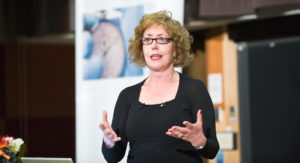Access to information can mean the difference between life and death. This is especially true for families advocating for their loved ones with serious medical conditions. When a doctor isn’t well versed in a certain disease and there is a crisis, a family member armed with evidence-based information can play a life saving role.
Pat Furlong knows this scenario all too well as a mother of two sons who died as teenagers from a rare muscle disorder.
When Furlong’s boys were ages 4 and 6 they were more likely to sit and color than to jump off couches. She didn’t accept her doctor’s reaction that they were just quiet kids. They weren’t hitting their expected milestones and Furlong suspected something was wrong.
Christopher and Patrick were diagnosed in 1984 with Duchenne muscular dystrophy. It was a devastating prognosis: They would develop skills and then lose them, slowly dying by the age of 25.
Furlong, a nurse, and her husband, Tom, a physician, tried to become experts on the condition so they could advocate for the best care. They drove from their small town of Middletown, Ohio, 35 miles to Cincinnati to research the condition at medical libraries. They were lucky to have access to information that, for many families, can be a costly with copies running $25 or more a piece.
It’s essential for families to keep up with the latest research regarding a loved one’s condition so they can help inform health care providers who may lack expertise.
“To someone in fragile health, you have one shot. If you are wrong, it can be the end of life,” says Furlong.
In 1995, Christopher developed pneumonia and respiratory distress. The Furlongs brought their son to the local ER. As is in the case in many rural areas, the physicians had little or no exposure to rare conditions. They treated Christopher’s pneumonia with a standard protocol – drugs and incubation. Christopher, at age 17, died. Later, the Furlongs realized that this was probably not the right approach given his condition. But at the time, information was not available that would have indicated anything other treatment.
Patrick died seven months later at the age of 15.
The boys’ health rode on a tightrope, says Furlong, and any change could have sent them into a downward spiral. Also physicians can’t be expected to know about every rare condition and how best to treat in an emergency. But with the Internet, there is an opportunity for families to equip themselves with information that can bring medical providers up to speed.
“This is exactly the reason I fight for access to information,” says Furlong. “In a catastrophic rare disease, the stakes are very high. Without access to information, you don’t stand a chance.”
Furlong, now president of Parent Project Muscular Dystrophy, pushes for open access to the latest medical research. Although presenting a paper to a doctor about a certain treatment may not convince them, it starts a dialogue. “It allows this wonderful communication and assurance for me, the mom, to know that my son is getting the best care,” say Furlong, who also has two grown daughters.
Research funded through public dollars should be available free after a reasonable period of time, says Furlong. “Research is the key. The more information you have, the stronger you can be and have more realistic hopes,” she says. “The more information you have, the better decisions you can make. Information is power.”
Read the 2010 profile of Pat Furlong in the New Yorker, “Mother Courage: A Family Tragedy and a Scientific Crusade”
Prepared for SPARC/ATA by Caralee Adams
